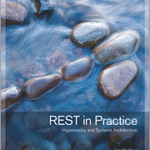Bad
Let’s start with the bad and everything else would be an improvement when compared with that. Yes, food at the conference is awful. I thought that’s only me who is looking out for vegetarian options, but apparently many people I knew who eat mostly anything under the Sun (no disrespect) are also equally disappointed. There is a huge scope for improvement in this area.
Some other aspects that need some attention — it was a huge effort for the first couple of days to find the right conference room in Hilton and in Parc55; folks sitting towards the back couldn’t see the slides that well because of the placement of the screen and projector; Poor wifi, worked intermittently. I hope Oracle considers moving Java One to Mascone in the future.
Good
Now that we put the worst behind us I will go to the other extreme and explain what’s the best. Yes, there are some good sessions that I attended which I will go over in a minute. But the best part is meeting people and exchanging ideas. I got an opportunity to meet a whole lot of people I know for a while, worked with them online or exchanged tweets but got a chance to meetup for the first time. What more? I have even found a childhood friend whom I lost contact for the last few years!
Sessions
I will summarize some of the sessions that I liked at the conference (and skipping the ones that didn’t appeal to me much):
Script Bowl 2010: A Scripting Languages Shootout
Clojure, Groovy, JRuby and Scala are the contending languages this time. They were presented by Rich Hickey, Graeme Rocher, Nick Sieger and Dick Wall respectively. Roberto Chinnici of Oracle acted as a judge/coordinator. Two rounds of presentations took place — first round dealing with the language features and the second one presenting community features. Liked what I saw about Spock.
It was all in a rapid fire mode as the time allotted is only one hour. I was actually thinking that to be a competition where a specific problem or two would be assigned to each person representing the language and then evaluate how each language approaches the problem. But apparently that’s not the case.
The winner was announced based on the audience applause at the end, just for fun, I guess. Groovy topped followed by Scala as a close second.
Advanced Java API for RESTful Web Services (JAX-RS)
Paul Sandoz and Paul Chinnici started off with an overview of JAX-RS — going over basic annotations (@Path, @Produces, etc.). Runtime resource resolution was dealt with in good detail. Middle part of the presentation was over integrating JAX-RS with EJBs and CDI (Yawn! I’m not much into it CDI).
Then they woke me up with some good discussion over content negotiation and conditional request support of JAX-RS. JAX-RS has got great content negotiation support covering media type, character set, language, and content encoding. Variant API is nice and flexible.
Equally nice is its support for conditional requests (GETs and PUTs) for caching representations and for concurrency control. They have demoed ETag validation and evaluatePrecondition flow.
“If you think you understand Java Generics than actually you don’t understand it!” – a quote from the presenters that drew some laughs. The speakers went over how they had to deal with the type erasure issue and a work around of using GenericEntity to preserve type information at runtime. They finished the presentation discussing the pluggable exception handling mechanism of JAX-RS.
Overall, a nice presentation. I have expected them to discuss hypermedia support in Jersey but because of time constraint they couldn’t get to it, as Paul Sandoz suggested after the talk when I asked him about it.
The Next Big Java Virtual Machine Language (NBJL)
Stephen Colebourne of OpenGamma is the speaker of this talk with potential controversy from the title itself. There are a lot of folks who swear by their language of choice, for what its worth, I thought it would be interesting to see what conclusion the presenter would arrive and based on what analysis. (There is also another section of people who completely denounce of the notion of NBJL. They consider polyglot programming is here to stay and there is not going to be one big successor, and you choose a language that best serves your task at hand. Let’s leave that view point for another day!).
Colebourne defined what he thinks a next big language would be, one that’s widely used (big job market) with supporting ecosystem and community. Examples: C, C++, Java, C#, Cobol, VB, Perl, PHP, Javascript, etc. So NBJL is one that challenges Java and eventually displaces it.
There are a lot of design decisions that were made at various points while Java was evolving. Many of them appeared to be right at that point and only after some experience people started to realize that there are better ways to approach. The speaker went over few items that are sore points in Java and what we have learnt from the real world experiences, from technology advancements, and from the other new breed of languages. Colebourne went over checked exceptions, primitives, arrays, ‘everything is a monitor’ concept, static methods, method overloading, and generics as some areas where NBJL could provide some solid alternatives.
Colebourne presented what can Java do to evolve still maintaining the “feel of Java”. Bigger challenges for Java at this point are supporting — Properties, Continuations, Control abstraction, Traits, Immutability, Design by Contract, and Reified generics. Another important point the speaker made was that the NBJL should be a “blue collar” language, a language of the masses. An average developer should be able to pick it up rather quickly and be productive in a reasonable time frame.
Towards that end the presenter looked at various languages: Clojure, Groovy, Scala, Fantom and discarded every one of them with some justification. Here is where it gets interesting. He concludes with a thought may be that Java should come up with a backward incompatible version and fix its warts. Regardless of how you respond to the concluding thought it was an excellent presentation overall covering a wide spectrum of concepts. If you are interested to hear from the presenter himself check this out.
NoSQL Alternatives: Principles and Patterns for Building Scalable Applications
Nati Shalom of GigaSpaces presented data scalability patterns that emerged out of various NoSQL projects. He compared the new breed of technology against the traditional database scaling approach in terms of consistency, transaction and query semantics.
Some of the factors that are affecting the scalability needs — social networks changed the web experience in the recent years. Read-mostly applications transformed into read/write and mostly predictable traffic has become a viral one with huge spikes at certain time intervals triggered by the events. SaaS model and cloud is mentioned as a factor. The speaker suggests that the economic downturn has forced the corporates to work efficiently, and no more that throwing more expensive hardware at the problem is an appealing solution.
Another factor that the speaker suggested was that the disk failures are up and lot higher than what are actually reported by the vendors (3% actual vs 0.5% reported). With the advancements in technology memory can be 100 – 1000x more efficient than the disk. RAMClouds become much more attractive for applications with high throughput requirements. New hardware makes it possible to store the entire set of data in-memory.
The presenter went over various alternatives: In-memory (GigaSpaces), Key/Value. Column (BigTable, HBase), Document model (CouchDB), Graph (Neo4J). Shalom discussed common principles behind the NoSQL alternatives like – design for failure; scale through partitioning of the data; maintain reliability through replication; provide flexibility between consistency, availability and partition failure; dynamic scaling. Some other principles (not so common) discussed are – document model support, SQL query support, MapReduce, transaction management, and security.
To be continued …
See here for part 2 of the series.





